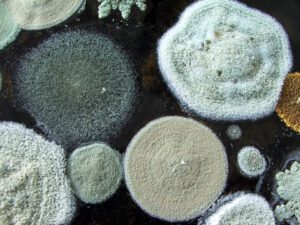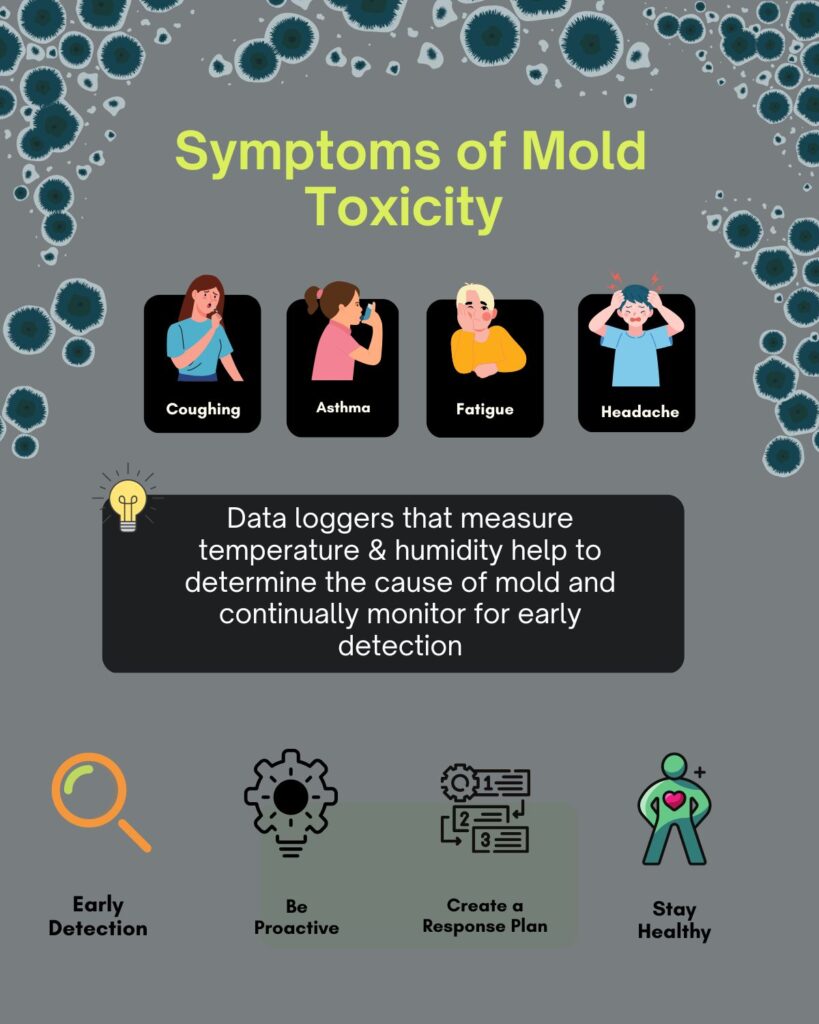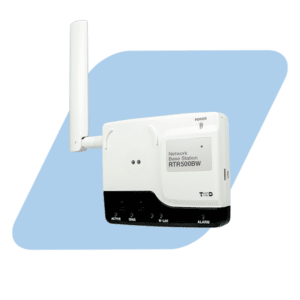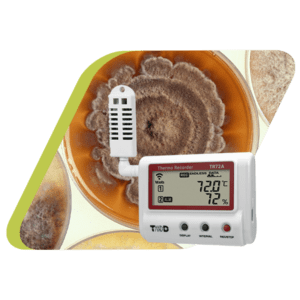 Mold—a common type of fungi—can take hold in any humid area such as around windows, leaky pipes, carpeting, or saturated areas like wet basements. Once mold enters your building, it can quickly thrive and spread, causing a wide variety of health problems including coughing, rashes, allergies, and asthma complications. Fortunately, you can use a temperature and humidity data logger to continually monitor your building for environmental conditions conducive to mold growth. In this White Paper, CAS DataLoggers details how you can use an environmental data logger to guard against mold in your home or business.
Mold—a common type of fungi—can take hold in any humid area such as around windows, leaky pipes, carpeting, or saturated areas like wet basements. Once mold enters your building, it can quickly thrive and spread, causing a wide variety of health problems including coughing, rashes, allergies, and asthma complications. Fortunately, you can use a temperature and humidity data logger to continually monitor your building for environmental conditions conducive to mold growth. In this White Paper, CAS DataLoggers details how you can use an environmental data logger to guard against mold in your home or business.
You Need to Be Proactive Against Mold Growth:
Mold thrives in high-humidity areas including basements, showers, greenhouses, summer homes, areas under construction, etc. After a few days of being saturated with water, an area often shows visible fungal colonies. Mold is notoriously difficult to eradicate from an area once it has taken hold. Typically-encountered molds include Cladosporium, Aspergillus, Penicillium, and more.
Since mold also spreads quickly to paper and wood, libraries and museums are always on the watch for the spotty discolorations and damp smells that reveal mold. Relative Humidity (RH) values of 95% or higher and temperatures between 77°F and 86°F are ideal conditions for spores to germinate. Once you’ve identified mold patches, clean them from non-porous surfaces using purpose-made cleaning products or soap and water. While you should remove mold as soon as you see it, by then the damage is already done to products and furnishings. In some cases, it may be impossible to completely remove the mold and you may be forced to destroy all affected materials. Obviously, in the case of furnishings, hardcopy records, or historical documents, this is an unacceptable risk.
In Businesses:
Regardless of size, businesses are liable for health risks posed to their employees, and that includes those caused by mold growth. Health issues (including asthma complications and fever) can be lessened or prevented beforehand by immediately finding and removing mold colonies.
In Residences:
Inside houses and apartments, mold can cause respiratory health issues in children, so homeowners and landlords alike can benefit from using temperature and humidity data loggers. Their sensors can be instrumental in finding the source of water or humidity ingress. You should also add ventilation to high-temperature areas such as showers and basements. Adjusting AC, climate control, and dehumidifiers according to the season can help. Following any sudden water incursion, be sure to thoroughly dry out the area. Take special care to check and clean furnishings, plants, and other vulnerable items. Throw out any affected materials which can’t be cleaned or saved.
Help Prevent Mold Using Environmental Data Loggers:
While the CDC doesn’t recommend that businesses and organizations routinely take samples for mold (owing to the expense and time), the Internet of Things offers a more convenient way to monitor the environment for conditions leading to mold growth. Many facilities now use an environmental monitoring system as an automated way to accomplish this.

Temperature and humidity data loggers are an effective way to monitor at-risk environments for the warm and humid conditions that quickly give rise to mold. A common setup involves a wireless base station or gateway mounted on a wall, connected to one or more wireless temperature/humidity data loggers on wall brackets.
Each logger has an internal or external sensor monitoring its surrounding temperature and humidity. Each device is specified to record at a certain window, i.e. -60°C to 155°C or 10% to 95% RH.
Since humidity levels and exterior/interior temperatures fluctuate during the day and night, data loggers continually monitor their environment. Users select a sampling rate, which is the frequency that the device takes a sample of the surrounding temperature or humidity. These devices also have LCD displays making them useful for spot checks.
 If you need to record additional measurement values, devices are available that also record carbon dioxide, light, pressure, and more. If accuracy is a concern, you can opt for a higher-accuracy model.
If you need to record additional measurement values, devices are available that also record carbon dioxide, light, pressure, and more. If accuracy is a concern, you can opt for a higher-accuracy model.
Additionally, if you need to receive alarms and/or view the data from a remote location, you can use a wireless data logger to check data online from any web-enabled device including your PC, laptop, or mobile device. Many models are waterproof for extra protection. Wireless range varies, but many models have more than adequate coverage of indoor areas, typically up to 500 ft.
Alarms can be in the form of text messages or email warning notifications. Many different models let you choose how you receive alarms, including SMS text messages and emails. Using a wireless data logger, users can check conditions and get alarm notifications whenever needed.
Early Leak Detection:
Water leaks are common causes of mold growth via leaky water pipes, damaged AC systems, foundation leakage, and patchy flooring or roofs. ASHRAE (American Society of Heating, Refrigerating and Air-Conditioning Engineers) guidelines recommend that facility staff monitor both temperature and humidity in each vulnerable room at multiple distributed points.
For early detection of water leaks, you can also utilize a Water Leak Detector. A common style is the “rope” sensor which consists of a pair of twisted wires and a signal conditioner. It can be placed anywhere there is the potential for standing water. The output is an off/on switch that can be connected to a digital data logger to generate an alarm whenever water is present at any point along the rope.
After just a few seconds of contact with water, the sensor’s alarm relay changes its state and the sensor goes into alarm mode, for example by flashing a red LED alarm light or sounding an external alarm horn. Many wireless data loggers also send text message notifications to a mobile device, allowing users to take action in the event of incoming water. These precautions give you time to save business-critical equipment or irreplaceable family possessions.
In this way, an automated system can monitor all measurement parameters needed, including temperature, humidity, and water leaks. Using data logger software, users can view the collected environmental data at their convenience to better direct their climate control efforts. For example, if more leaks are found over time, it’s easy to add additional water sensors for greater floor coverage.

Create a Response Plan:
Meanwhile check to see if your facility manager or caretaker has an existing response plan concerning mold—if not, it’s time to create one yourself. This plan should outline which cleaning products and methodologies are appropriate for your specific facility or home. You should also write down plans for containing flood waters if this is a risk to your building.
Make sure to remove all possible causes of high moisture levels. Environmental data collected from loggers should help you to identify these. For example, you can set data logger alarms to trigger whenever humidity levels go over 50% as a good benchmark for mold growth conditions as recommended by the Centers for Disease Control and Prevention (CDC). When an alarm goes off, responsible parties can quickly take remedial measures like moving vulnerable material, turning on the AC, or activating a dehumidifier.
If your building is small enough, you might be able to delegate the list to one person or handle it yourself, but for more spacious facilities you may need a whole staff to handle it. Remember to wear adequate protection when cleaning mold, including face masks and disposable clothes. Also, ensure that any employees assigned to these tasks know and follow your response plan and any necessary health protocols.
If you need details on how to protect specific materials from water damage, the U.S.EPA has published guidelines online. For a comprehensive start, see Mold Remediation in Schools and Commercial Buildings (U.S. EPA, 2008).
Conclusion:
While mold growth is an ever-present threat in businesses and homes, you can stay on top of developing conditions by taking early precautions. In many buildings, temperature and humidity data loggers are ideal for identifying and alarming possible causes of mold, leaks, and other environmental damage. These environmental monitoring systems have convenient capabilities that—along with your own response plans—can effectively help protect your building from the elements.
About the Authors:
CAS DataLoggers is an American distributor of data loggers, paperless recorders, and data acquisition equipment. With data loggers from 1 to 300 channels, we can record temperature, humidity, pressure, flow, voltage, current, voltage, and more. We offer wireless, wired, serial (RS-232/RS-485), SDI-12 devices, and additional communications options. We have been in business for over 20 years and actively involved in distributing data loggers and real-time systems since 2001. Our staff has over 100 years of total experience with different types of data acquisition and measurement equipment.
To learn more about Temperature & Humidity Data Loggers, or to find the ideal solution for your application-specific needs, contact a CAS DataLoggers Application Specialist at (800) 956-4437 or request more information.

